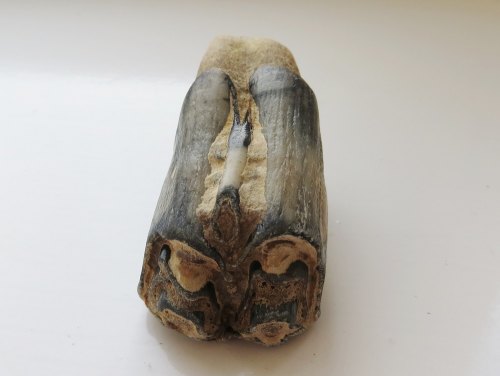
Image use policy
Our images can be used under a CC BY attribution licence (unless stated otherwise).
MAMMAL REMAINS
Unique ID: MAS-100008
Object type certainty: Certain
Workflow
status: Published ![]()
This tooth is a cattle (Bos spp) molar from the upper jaw. It has four crescentic cusps (polycuspid) forming a square crown, as well as four root elements. These characteristics are typical of selenodont teeth which are found in ruminant herbivores (e.g. cattle, goats, sheep, or deer). Viewed from the side, the crown of the tooth forms triangular profiles which, in combination with ridges, makes the sideways jaw motion of ruminants an effective way to break-up tough plant matter. Thus their function as crushing and grinding teeth.
The alternating layers of enamel, dentine and cementum are exposed. The surface of the neck of the tooth is white and grey, however, there is also a distinct bluish tinge to parts of the tooth that may indicate the presence of the iron phosphate mineral, vivianite. The presence of vivianite attached to bones is generally accepted as evidence of subfossil status.
Providing a relative date for this tooth is challenging as there are numerous reasons as to why it has not fully fossilised. It may be that not enough time has elapsed since the animal died, or the conditions in which the remains were deposited may not have been optimal for fossilisation. While the domestication of cattle occurred approximately 10,500 years ago in the Near East, it is generally accepted that domesticated cattle first appeared in England during the Neolithic (circa 4,000 BC) (Lynch et al. 2008).
Class:
Ecofacts
Sub class: Vertebrate remains
Subsequent actions
Current location of find: With finder
Subsequent action after recording: Submitted as wreck to the Receiver of Wreck
Chronology
Broad period: UNKNOWN
Period from: NEOLITHIC
Period to: POST MEDIEVAL
Dimensions and weight
Quantity: 1
Discovery dates
Date(s) of discovery: Thursday 1st January 2015
Personal details
Found by: This information is restricted for your login.
Recorded by: M F
Identified by: V L
Secondary identifier: L H
Materials and construction
Primary material: Animal skeletal material
Completeness: Complete
Spatial coordinates
4 Figure: NZ3279
Four figure Latitude: 55.1043857
Four figure longitude: -1.50000143
1:25K map: NZ3279
1:10K map: NZ37NW
Display four figure position on What3Words
Grid reference source: From finder
Unmasked grid reference accurate to a 1 metre square.
References cited
- Lynch, AH, Hamilton, J and Hedges REM, 2008. Where the wild things are: Aurochs and cattle in England. Cambridge University : Antiquity, ,
Similar objects

Find number: MAS-100017
Object type: MAMMAL REMAINS
Broadperiod: UNKNOWN
This cattle mandible, or lower jaw, is comprised of two incomplete sections; cattle mandibles are rarely encountered in the archaeological rec…
Workflow: Published![]()

Find number: MAS-100007
Object type: SPOON
Broadperiod: MODERN
This spoon is made of a metal alloy, possibly copper alloy, and was probably originally plated. Its manufacture would have been cast. The Roya…
Workflow: Published![]()

Find number: MAS-D100100
Object type: BOTTLE
Broadperiod: NINETEENTH CENTURY
A collection of five bottles comprising two full-size glass bottles, one squat cylindrical glass bottle, one small clear bottle, and one stone…
Workflow: Published![]()





